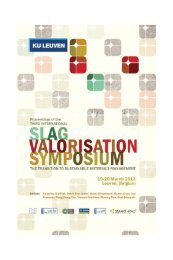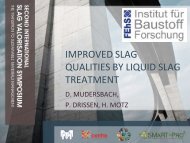International Slag Valorisation SymposiumLeuven6-7/4/2009 - Third ...
International Slag Valorisation SymposiumLeuven6-7/4/2009 - Third ...
International Slag Valorisation SymposiumLeuven6-7/4/2009 - Third ...
Create successful ePaper yourself
Turn your PDF publications into a flip-book with our unique Google optimized e-Paper software.
low costs and possibly higher reactivity, relative to mineral ores. Although their total<br />
CO 2 sequestration capacity is limited relative to total anthropogenic CO 2 emissions, the<br />
use of residues as feedstock can contribute to make the first mineral CO 2 sequestration<br />
(demonstration) plants economically feasible. 2)<br />
In addition to its possible contribution to the reduction of CO 2 emissions, carbonation of<br />
alkaline solid residues has been demonstrated to have potentially beneficial effects on<br />
the leaching of constituents from these materials to the environment. For example,<br />
reduced leaching of potentially harmful constituents has been reported for residues such<br />
as municipal solid waste incineration (MSWI) bottom ash, fly ash from coal fired power<br />
plants, air pollution control residues, and steel slag (see Huijgen & Comans 3) , and<br />
references therein). In such studies, a number of possible carbonation mechanisms has<br />
been distinguished that affect leaching, such as (1) precipitation of carbonates, (2) pHneutralisation,<br />
(3) formation of minerals other than carbonates, (4) co-precipitation and<br />
(5) sorption on freshly precipitated surfaces. Leaching experiments combined with<br />
geochemical modelling, and mineralogical characterisation (e.g. by X-ray diffraction<br />
and electron microscopic analyses) have been shown to be valuable tools to study the<br />
leaching properties and underlying mechanisms of these residues.<br />
This paper reviews a number of recent studies in which the authors have focused on the<br />
mineral carbonation mechanisms and potential of steel slag, as well as on the leaching<br />
properties of freshly produced steel slag and steel slag at various degrees of carbonation.<br />
By combining controlled carbonation and leaching experiments, geochemical modelling<br />
and mineralogical analyses, these studied are aimed to provide a mechanistic insight<br />
into (1) the mineral CO2 sequestration potential of steel slag and (2) the effects of the<br />
carbonation processes on the leaching properties of steel slag, including pH, redox<br />
potential (Eh), major and trace elements. As such, these studies are intended to<br />
contribute to the development of a treatment process that can facilitate the beneficial<br />
utilisation of steel slag.<br />
Materials and Methods<br />
Steel slag samples<br />
Two types of converter slags have been selected for carbonation experiments at<br />
atmospheric pressure (see below), each derived from a single heat, representing the<br />
maximum difference in primary mineralogy: K1 slag, which consists mainly of C2S<br />
(2CaO.(Si,P,V)O 4), C 2F (2CaO.(Fe,Ti,Al,V) 2O 3) and magnesio-wuestite (MW;<br />
(Fe,Mg,Mn)O), and K3 slag, which contains C3S (Ca3SiO5), C2S, C2F, MW and freelime<br />
(CaO). 1) The C3S is a high-temperature phase which decomposes to C2S + lime<br />
during cooling, but leaves a characteristic intergrowth texture, possibly with a different<br />
1 st <strong>International</strong> <strong>Slag</strong> <strong>Valorisation</strong> Symposium│Leuven│6-7/4/<strong>2009</strong><br />
40







